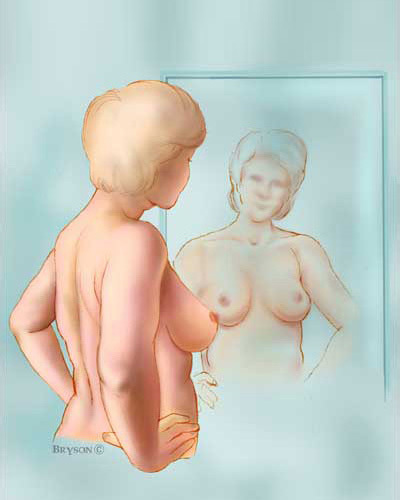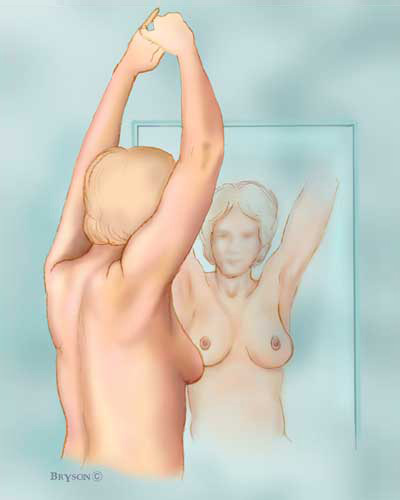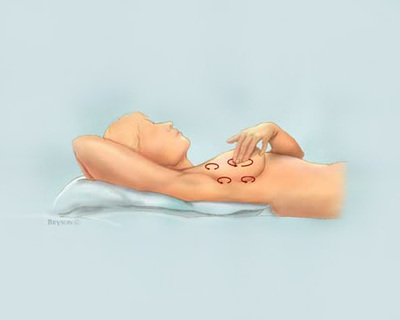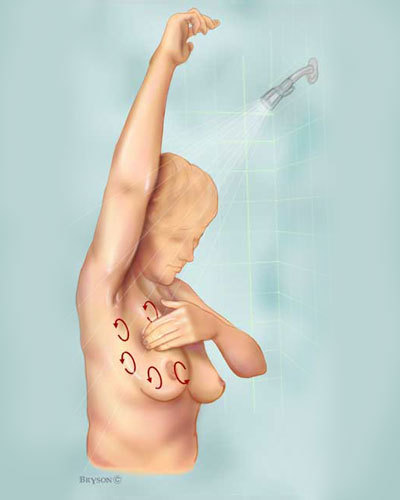Five Steps of a Breast Self-Exam

1/17/2018 8:59:25 AM
Not only are breasts the woman's natural beauty, they also play a vital part in being a wife and a mother. However, not all women know how to take good care of their breasts and protect themselves from health risks such as breast cancer.
Breast self-exam (BSE), or regularly examining your breasts on your own, can be an important way to find a breast cancer early, when it's more likely to be treated successfully. About 20% of the time, breast cancers are found by physical examination rather than by mammography. Here are the basic steps:
STEP 1

Begin by looking at your breasts in the mirror with your shoulders straight and your arms on your hips.
Here's what you should look for:
- Breasts that are their usual size, shape, and color
- Breasts that are evenly shaped without visible distortion or swelling
If you see any of the following changes, bring them to your doctor's attention:
- Dimpling, puckering, or bulging of the skin
- A nipple that has changed position or an inverted nipple (pushed inward instead of sticking out)
- Redness, soreness, rash, or swelling
STEPS 2-3

Now, raise your arms and look for the same changes.
While you're at the mirror, look for any signs of fluid coming out of one or both nipples (this could be a watery, milky, or yellow fluid or blood).
STEP 4

Next, feel your breasts while lying down, using your right hand to feel your left breast and then your left hand to feel your right breast. Use a firm, smooth touch with the first few finger pads of your hand, keeping the fingers flat and together. Use a circular motion, about the size of a quarter. Cover the entire breast from top to bottom, side to side — from your collarbone to the top of your abdomen, and from your armpit to your cleavage. Follow a pattern to be sure that you cover the whole breast. You can begin at the nipple, moving in larger and larger circles until you reach the outer edge of the breast. You can also move your fingers up and down vertically, in rows, as if you were mowing a lawn. This up-and-down approach seems to work best for most women. Be sure to feel all the tissue from the front to the back of your breasts: for the skin and tissue just beneath, use light pressure; use medium pressure for tissue in the middle of your breasts; use firm pressure for the deep tissue in the back. When you've reached the deep tissue, you should be able to feel down to your ribcage.
STEP 5

Finally, feel your breasts while you are standing or sitting. Many women find that the easiest way to feel their breasts is when their skin is wet and slippery, so they like to do this step in the shower. Cover your entire breast, using the same hand movements described in STEP 4.
NOTES
- Try to get in the habit of doing a breast self-examination once a month to familiarize yourself with how your breasts normally look and feel. Examine yourself several days after your period ends, when your breasts are least likely to be swollen and tender. If you are no longer having periods, choose a day that's easy to remember, such as the first or last day of the month.
- Don’t panic if you think you feel a lump. Roughly 80% of lumps in women's breasts are caused by benign (noncancerous) changes, cysts, or other conditions.
Don't forget to:
Exercise
The American Cancer Society recommends getting at least 150 minutes of moderate-intensity exercise per week (ideally, spread out, not all at once). Any kind of cardio will do, so hop on your bike or hit the nature trail. If your time is limited, exercising at high intensity for 75 minutes a week will have the same benefit.
Eat more foods with vitamin D, calcium, axid folic
- Mushrooms: Certain types of mushrooms are able to boost the body’s ability to fight cancer cells. The beauty of these mushrooms is that they are food and have virtually no side effects unless of course you are allergic to mushrooms.
- Green tea: Studies of Asian women found that those who drank green tea had significantly less breast cancer than those who did not drink it.
- Vegetables: Especially the cruciferous ones such as broccoli, Brussels sprouts, and cauliflower. The indol-3-carbinol in the vegetables may reduce the negative effect of estrogen on the breast.
- Soy in the form of food (such as tofu) can also help prevent breast cancer through a similar mechanism.